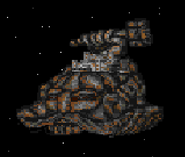Dwarven citadels were asteroids that had been converted into spelljamming vessels and bases. They were powered by large forges operated by dwarves.[1]
Description[]
More than mere vessels, citadels were also bases and homes to the dwarves inhabiting them. They were equipped with a different kind of spelljamming helm known as forges, which were powered by the mining activities of its inhabitants as they explored minerals within the asteroid itself.[1]
Capable of moving citadels up to 700 tons in size, forges provided energy for spelljamming and produced about 10,000 gp worth of dwarven items per month.[3] A typical citadel was capable of providing ores and prime materials for a limited amount of time, depending on its size. A 300-ton citadel, the smallest variant, could last between 6 and 24 years.[1]
After having been depleted of its resources, a citadel was emptied by its inhabitants and the whole clan, along with the forge, was transferred to a new asteroid. Abandoned citadels typically became lairs of monsters or pirates. They also tended to attract adventurers in search of treasure that might have been left behind.[1]
Most of the living space within a citadel was occupied by the forge. All its inhabitants worked the mines constantly and were organized in the same hierarchical structure as land-dwelling dwarf communities: the captain was called "king under the mountain", the command crew was called the "shining council", and so on. Kings were friendly and respectful towards other spacefaring dwarven clans, always happy to celebrate their encounters in space and to compare travel notes and genealogical records.[1]
Most citadels were living ships, home to their inhabitants and dedicated to exploration or trade, according to their populations' wishes. However, some citadels, known as jihad ships, were dedicated to waging war against sworn enemies of the dwarven race. Such crusades were declared by a council of representatives of several dwarven pantheons. Planets and ships belonging to their enemies were attacked on sight relentlessly.[1]
Large citadels were hard and difficult to maintain and for that reason were quite rare. Even larger citadels existed, of over 700 tons. However, those bases could not achieve spelljamming speeds and were most frequently used as stationary or orbiting bases.[1]
History[]
By the mid-14th century DR, the neogi were the sworn enemies of dwarves in space and were targeted on sight by jihad citadels.[1]
At least two of the Tears of Selûne were in fact large dwarven citadels orbiting Toril. One, known simply as the Citadel, was the main hub for Torilian dwarves traveling into Realmspace.[4] The other, called Whitestone, was inhabited by a group of mountain dwarves known as the Whitebeards, who mined Mount Hotenow during the winter. By the mid-14th century DR, the dwarves were led by King Gundulph Whitebeard VII.[5]
Appendix[]
Gallery[]
Appearances[]
Adventures
Video Games
Organized Play & Licensed Adventures
External Links[]
- Dwarven citadel article at the Spelljammer Wiki.
References[]
- ↑ 1.0 1.1 1.2 1.3 1.4 1.5 1.6 1.7 1.8 1.9 Jeff Grubb (August 1989). “Lorebook of the Void”. Spelljammer: AD&D Adventures in Space (TSR, Inc.), pp. 45–47. ISBN 0-88038-762-9.
- ↑ Dale "slade" Henson (March 1992). “Ship Recognition Manual”. In Jon Pickens ed. War Captain's Companion (TSR, Inc.), p. 13. ISBN 1-56076-343-4.
- ↑ Jeff Grubb (August 1989). “Concordance of Arcane Space”. Spelljammer: AD&D Adventures in Space (TSR, Inc.), p. 37. ISBN 0-88038-762-9.
- ↑ Dale "slade" Henson (April 1991). Realmspace. Edited by Gary L. Thomas, Karen S. Boomgarden. (TSR, Inc), p. 30. ISBN 1-56076-052-4.
- ↑ Shonn Everett (March/April 1991). “Visitors from Above”. In Barbara G. Young ed. Dungeon #28 (TSR, Inc.) (28)., pp. 53, 68.

